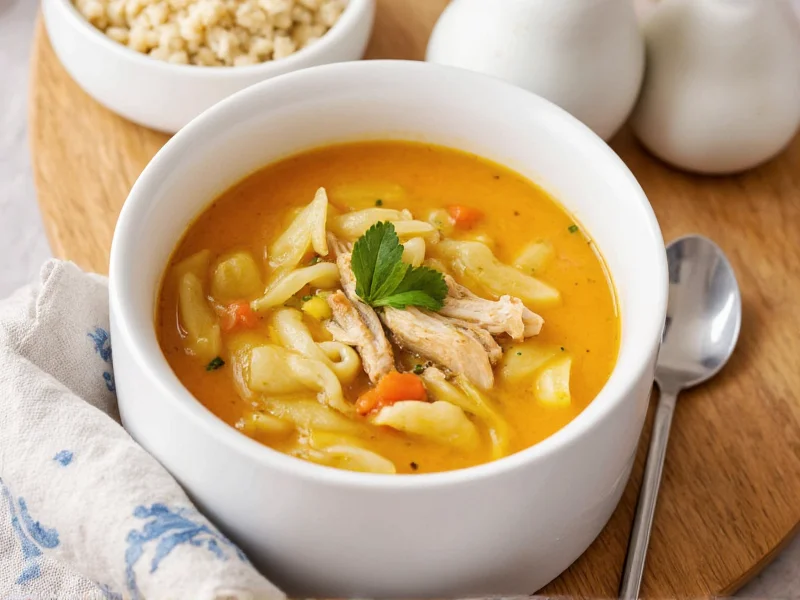The Essential Components of Authentic Chicken Pasta Soup
Creating exceptional chicken pasta soup requires understanding its fundamental elements. Unlike basic chicken noodle soup, pasta soup features specific ingredients that create its distinctive character. The magic happens when quality chicken stock meets perfectly cooked pasta and tender chicken pieces.
| Core Ingredient | Recommended Quantity | Substitution Options |
|---|---|---|
| Chicken broth | 6 cups low-sodium | Homemade stock, vegetable broth |
| Chicken breast/thighs | 1.5 lbs boneless, skinless | Cooked rotisserie chicken |
| Diced vegetables | 2 cups total (carrots, celery, onion) | Leeks, fennel, parsnips |
| Dried pasta | 1.5 cups small shapes | Orzo, ditalini, small shells |
| Herbs | 2 tbsp fresh parsley, 1 tsp thyme | Dried herbs (use 1/3 amount) |
Step-by-Step Preparation Guide
Follow these professional techniques to achieve restaurant-quality chicken pasta soup at home. The key to preventing mushy pasta lies in the cooking sequence—always add pasta during the final 8-10 minutes of simmering.
- Sauté aromatics: Heat olive oil over medium heat, then cook diced onions, carrots, and celery until softened (5-7 minutes)
- Brown chicken: Add cubed chicken pieces and cook until golden (do not fully cook through)
- Build broth: Pour in broth, scraping browned bits from pan bottom for maximum flavor
- Simmer: Partially cover and simmer 15 minutes until chicken reaches 165°F internal temperature
- Add pasta: Stir in dried pasta and cook according to package directions minus 2 minutes
- Finish: Remove from heat, add fresh herbs, and let sit 5 minutes before serving
Mastering Variations for Different Preferences
Adapt this versatile recipe to suit various dietary needs and flavor profiles. For creamy chicken pasta soup with vegetables, stir in 1/2 cup heavy cream or coconut milk during the final simmer. Mediterranean versions benefit from adding white beans and spinach during the last 3 minutes of cooking.
When exploring how to make chicken pasta soup from scratch with different pasta types, remember that smaller shapes like orzo or ditalini work best as they maintain texture during storage. Avoid long pasta strands which become tangled and overcook easily in soup.
Pro Tips for Perfect Results Every Time
Prevent common mistakes with these chef-recommended techniques. Never add uncooked pasta directly to boiling broth—this releases too much starch and creates a gummy texture. Instead, cook pasta separately to al dente and add just before serving for meal prep versions.
For easy chicken pasta soup recipe success, toast dried pasta in the oven at 350°F for 5 minutes before adding to soup—this creates a protective layer that prevents disintegration. When using frozen vegetables, add them during the last 5 minutes to maintain crisp texture.
Storage and Reheating Guidelines
Proper storage ensures your homemade chicken pasta soup with vegetables maintains quality. Store components separately: keep broth and solids in one container, cooked pasta in another. This prevents pasta from absorbing excess liquid and becoming mushy.
Refrigerate for up to 4 days or freeze broth base for 3 months. When reheating, bring broth to simmer first, then add pasta and heat through. For frozen portions, thaw overnight in refrigerator before reheating gently over medium-low heat.
Nutritional Benefits and Dietary Adaptations
A standard serving (1.5 cups) provides approximately 280 calories, 22g protein, and essential vitamins from vegetables. To create gluten-free versions, use certified gluten-free pasta or substitute with quinoa. For lower sodium options, prepare broth from scratch using chicken bones and vegetable scraps.
Boost nutritional value by adding leafy greens like kale or spinach during the final minutes of cooking. These additions provide vitamins A and K without compromising the soup's comforting character—perfect for chicken pasta soup storage tips when meal prepping healthy lunches.
Frequently Asked Questions
Can I use cooked chicken in pasta soup?
Yes, add pre-cooked chicken during the final 5 minutes of cooking to prevent overcooking and maintain tenderness. Rotisserie chicken works well for quick preparation—simply shred 2 cups and stir in at the end.
Why does my pasta get mushy in soup?
Pasta absorbs liquid as it sits in hot soup. Prevent this by cooking pasta separately to al dente, then adding just before serving. For meal prep, store pasta separately from broth and combine when reheating.
What's the best pasta shape for chicken soup?
Small, sturdy shapes like ditalini, orecchiette, or small shells hold up best in soup. Avoid long strands or delicate filled pastas which break down quickly. For gluten-free options, brown rice pasta maintains better texture than corn-based alternatives.
How can I make chicken pasta soup creamy without dairy?
Puree cooked white beans or cauliflower with some broth to create a creamy texture. Alternatively, stir in 1/4 cup coconut milk during the final simmer for richness without traditional dairy. Blending part of the soup also creates natural creaminess.











 浙公网安备
33010002000092号
浙公网安备
33010002000092号 浙B2-20120091-4
浙B2-20120091-4